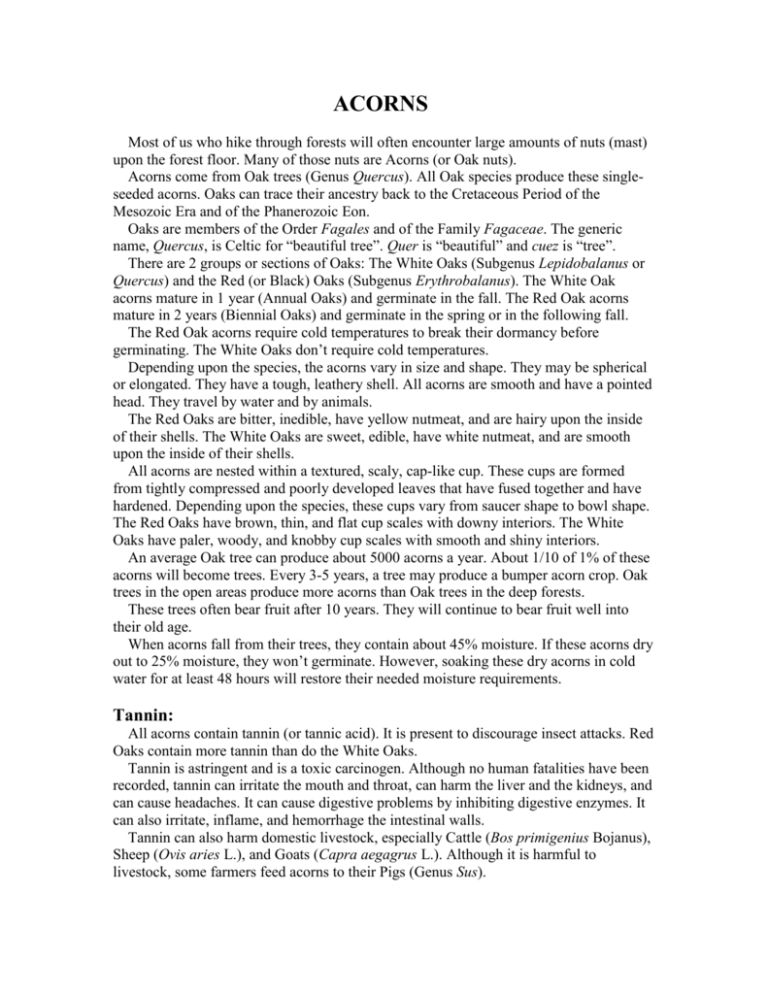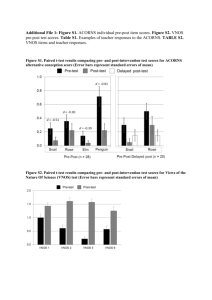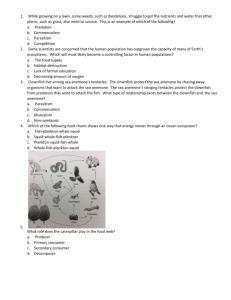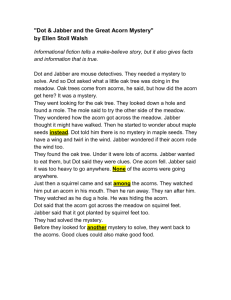Acorns - Indiana Native Plant & Wildflower Society
advertisement

ACORNS Most of us who hike through forests will often encounter large amounts of nuts (mast) upon the forest floor. Many of those nuts are Acorns (or Oak nuts). Acorns come from Oak trees (Genus Quercus). All Oak species produce these singleseeded acorns. Oaks can trace their ancestry back to the Cretaceous Period of the Mesozoic Era and of the Phanerozoic Eon. Oaks are members of the Order Fagales and of the Family Fagaceae. The generic name, Quercus, is Celtic for “beautiful tree”. Quer is “beautiful” and cuez is “tree”. There are 2 groups or sections of Oaks: The White Oaks (Subgenus Lepidobalanus or Quercus) and the Red (or Black) Oaks (Subgenus Erythrobalanus). The White Oak acorns mature in 1 year (Annual Oaks) and germinate in the fall. The Red Oak acorns mature in 2 years (Biennial Oaks) and germinate in the spring or in the following fall. The Red Oak acorns require cold temperatures to break their dormancy before germinating. The White Oaks don’t require cold temperatures. Depending upon the species, the acorns vary in size and shape. They may be spherical or elongated. They have a tough, leathery shell. All acorns are smooth and have a pointed head. They travel by water and by animals. The Red Oaks are bitter, inedible, have yellow nutmeat, and are hairy upon the inside of their shells. The White Oaks are sweet, edible, have white nutmeat, and are smooth upon the inside of their shells. All acorns are nested within a textured, scaly, cap-like cup. These cups are formed from tightly compressed and poorly developed leaves that have fused together and have hardened. Depending upon the species, these cups vary from saucer shape to bowl shape. The Red Oaks have brown, thin, and flat cup scales with downy interiors. The White Oaks have paler, woody, and knobby cup scales with smooth and shiny interiors. An average Oak tree can produce about 5000 acorns a year. About 1/10 of 1% of these acorns will become trees. Every 3-5 years, a tree may produce a bumper acorn crop. Oak trees in the open areas produce more acorns than Oak trees in the deep forests. These trees often bear fruit after 10 years. They will continue to bear fruit well into their old age. When acorns fall from their trees, they contain about 45% moisture. If these acorns dry out to 25% moisture, they won’t germinate. However, soaking these dry acorns in cold water for at least 48 hours will restore their needed moisture requirements. Tannin: All acorns contain tannin (or tannic acid). It is present to discourage insect attacks. Red Oaks contain more tannin than do the White Oaks. Tannin is astringent and is a toxic carcinogen. Although no human fatalities have been recorded, tannin can irritate the mouth and throat, can harm the liver and the kidneys, and can cause headaches. It can cause digestive problems by inhibiting digestive enzymes. It can also irritate, inflame, and hemorrhage the intestinal walls. Tannin can also harm domestic livestock, especially Cattle (Bos primigenius Bojanus), Sheep (Ovis aries L.), and Goats (Capra aegagrus L.). Although it is harmful to livestock, some farmers feed acorns to their Pigs (Genus Sus). Tannin may have medicinal uses. Tannin may someday be used in antiviral, antiseptic, and anticancer medicines. Presently, this is still within the experimental stage. Animal Consumers: Acorns are a staple diet for numerous bird species. Some of those bird species in this part of the country include Blue Jays (Cyanocitta cristata L.), American Crows (Corvus brachyrhynchos Brehm), Northern Cardinals (Cardinalis cardinalis L.), Common Grackles (Quiscalus quiscula L.), Mourning Doves (Zenaida macroura L.), Bobwhite Quails (Colinus virginianus L.), Woodpeckers (Subfamily Picinae), Wood Ducks (Aix sponsa L.), and Wild Turkeys (Meleagris gallopavo L.). Passenger Pigeons (Ectopistes migratorius L.) and Carolina Parakeets (Conuvopsis carolinensis L.), both extinct species, also ate acorns. Those bird species with larger bills are better able to crack open the acorns. Many Mammal (Class Mammalia) species from this part of the country consume these acorns. Most of them are Rodents (Order Rodentia), such as Mice (Genus Mus), Voles (Subfamily Arvicolinae), Eastern Chipmunks (Tamias striatus L.), Squirrels (Family Sciuridae), and Eastern Cottontail Rabbits (Sylvilagus floridanus J.A. Allen). Other mammal species include Virginia Opossums (Didelphis virginiana Kerr), Raccoons (Procyon lotor L.), Foxes (Tribe Vulpini), American Black Bears (Ursus americanus Pallas), and White-tailed Deer (Odocoileus virginianus Zimmermann). During the fall, about 25% of the White-tailed Deer’s diet is acorns. Squirrels consume acorns from both Oak groups, but not at the same time. Red Oaks have more fat than do the White Oaks. This extra fat helps the Squirrels survive the winter. Because the White Oak acorns sprout earlier than the Red Oak acorns, the Squirrels consume the White Oak acorns first. They bury the Red Oak acorns for later consumption after the White Oak acorns are gone. Many buried acorns that are not exhumed become Oak trees. Human Consumption: Humans have been eating acorns since prehistoric times. Archaeological excavations around the world have uncovered evidence that humans consumed them. Humans can eat acorns if they are properly prepared. They can be gathered in the fall. Acorns with wormholes in them should be discarded. The water-soluble tannin must be leached out before consumption. Keep Red Oak acorns and White Oak acorns separated. Acorns should be soaked in warm water for about 20-30 minutes. The acorns will soften, swell, and split. Floating acorns should be discarded. After soaking, the thin shells should be removed and the nutmeat should be boiled in several changes of water for about 2 hours. The water should be changed when it becomes light brown. After boiling, the nutmeat should be chopped or ground into nut meal and placed in a strainer or upon a clean cloth and doused with hot or boiling water until the water is clear. The acorns should also be roasted in an oven for about 1 hour at 350 degrees F. The Native Americans had their own methods of leaching. The acorns were either mixed with wood ashes (lye) and buried underground for several months to a year or were placed in running streams for a few to several days. Depending upon the species, acorns contain about 4-20% fat, about 2-5% protein, about 4% crude fiber, about 10% sugar, and about 30-70% carbohydrates. They also contain the vitamin niacin and minerals, such as calcium, magnesium, phosphorous, potassium, and sulfur. The acorn meal can be used as a flour substitute for making bread, cakes, noodles, pancakes, and muffins. They are used for thickening soups and are made into mush. Acorns can also be used as a coffee substitute. REFERENCES THE ENCYCLOPEDIA OF EDIBLE PLANTS OF NORTH AMERICA By Francois Couplan, Ph.D. EASTERN/CENTRAL MEDICINAL PLANTS By Steven Foster and James A. Duke TREES OF THE EASTERN AND CENTRAL UNITED STATES AND CANADA By William M. Harlow EAT THE WEEDS By Ben Charles Harris SQUIRRELS: A WILDLIFE HANDBOOK By Kim Long EDIBLE WILD PLANTS OF PENNSYLVANIA AND NEIGHBORING STATES By Richard J. Medve and Mary Lee Medve OAKS OF NORTH AMERICA By Howard Miller and Samuel Lamb EASTERN FORESTS By John C. Kricher and Gordon Morrison WILD FOOD PLANTS OF INDIANA AND ADJACENT STATES By Alan and Sue McPherson A NATURAL HISTORY OF TREES OF EASTERN AND CENTRAL NORTH AMERICA By Donald Culross Peattie EDIBLE WILD PLANTS By Lee Allen Peterson EASTERN TREES By George A. Petrides THE URBAN TREE BOOK By Arthur Plotnik WILD EDIBLE PLANTS OF NEW ENGLAND By Joan Richardson RED OAKS AND BLACK BIRCHES By Rebecca Rupp THE SIBLEY GUIDE TO TREES By David Allen Sibley WILLOW BARK AND ROSEHIPS By Fritz Springmeyer and Michele Montez TREES: THEIR NATURAL HISTORY By Peter Thomas THE USES OF WILD PLANTS By Frank Tozer COMMON POISONOUS PLANTS AND MUSHROOMS OF NORTH AMERICA By Nancy J. Turner and Adam F. Szczawinski TREES By Laurence C. Walker en.wikipedia.org/wiki/Acorn






